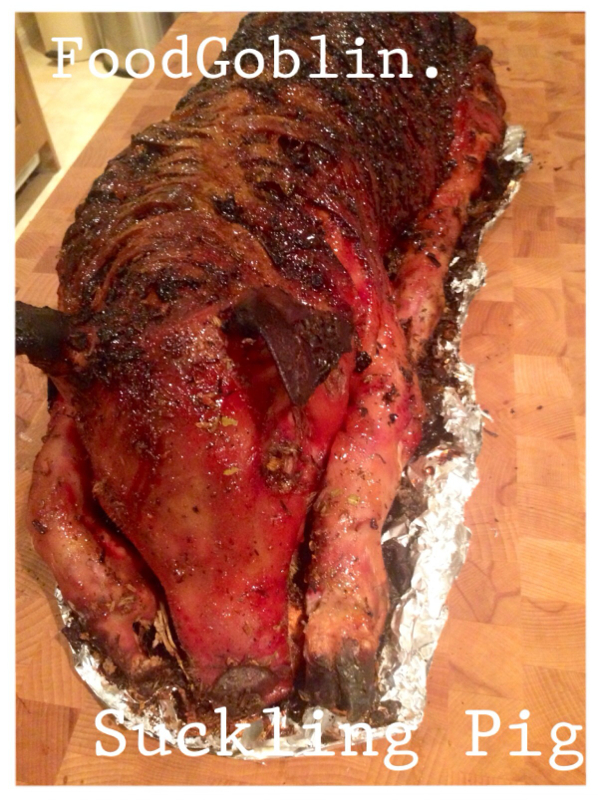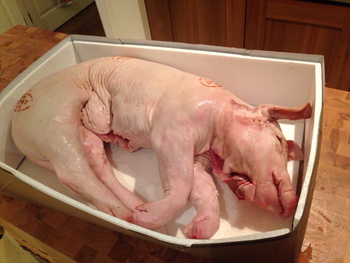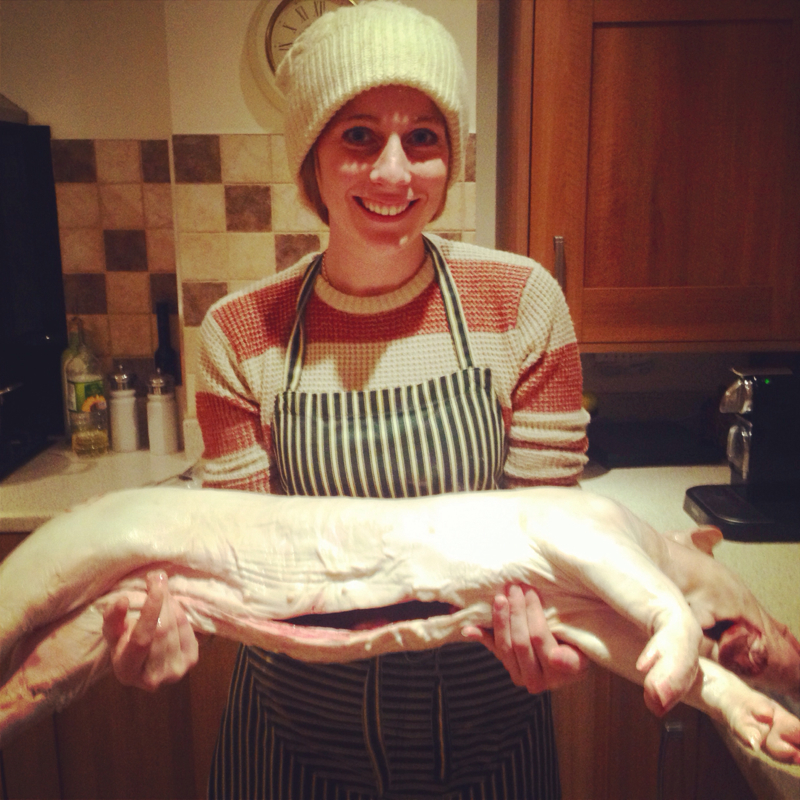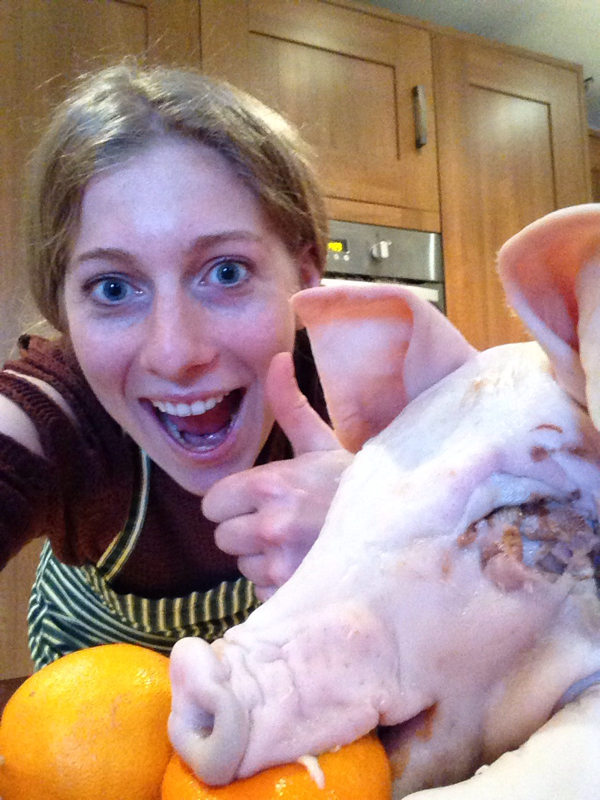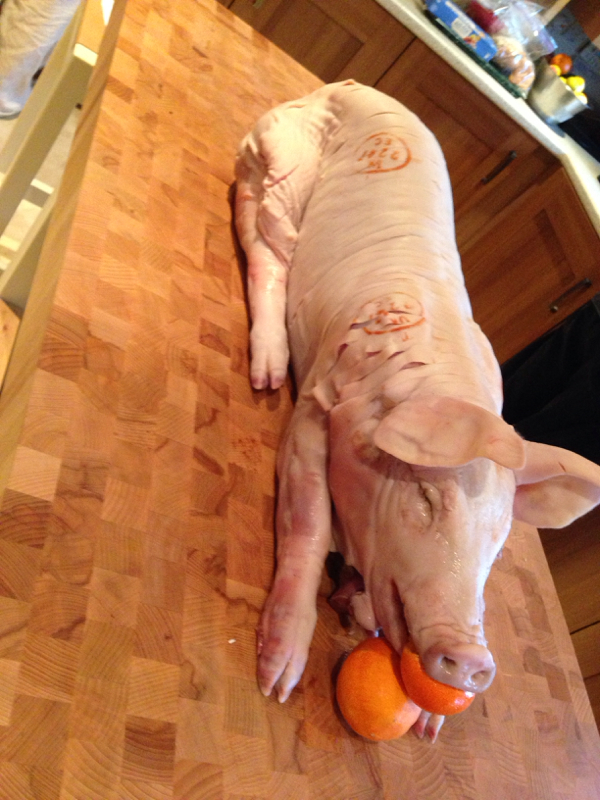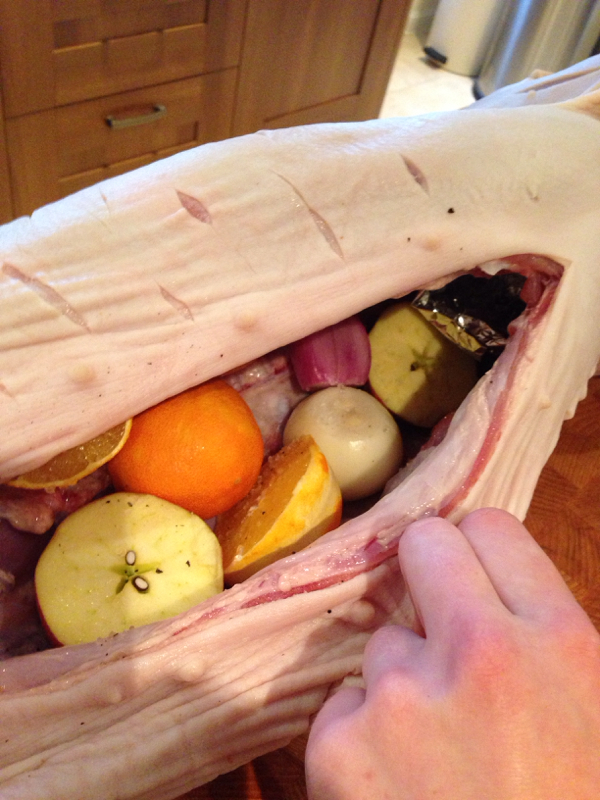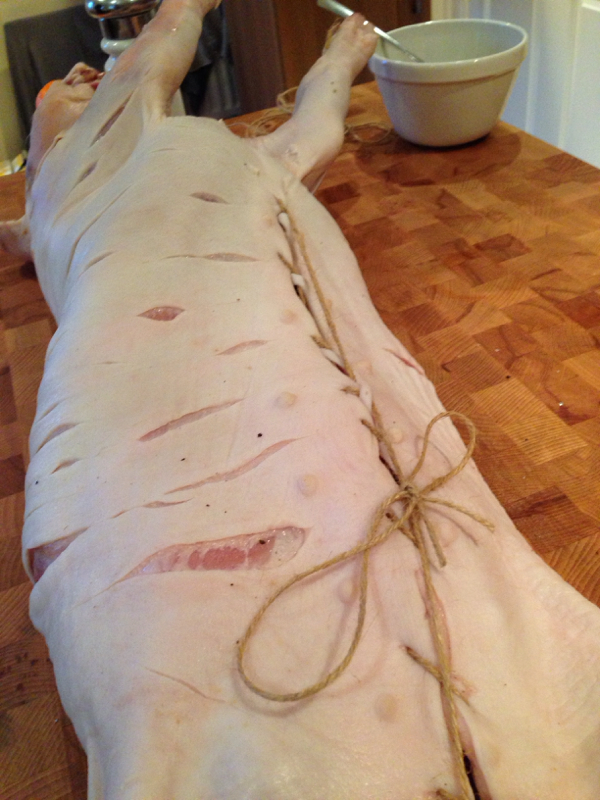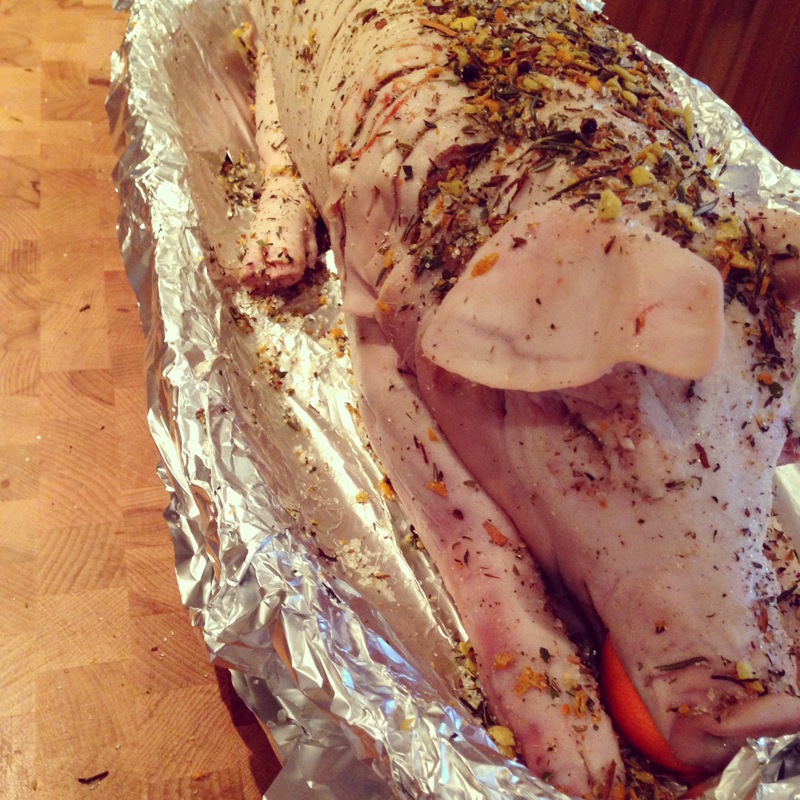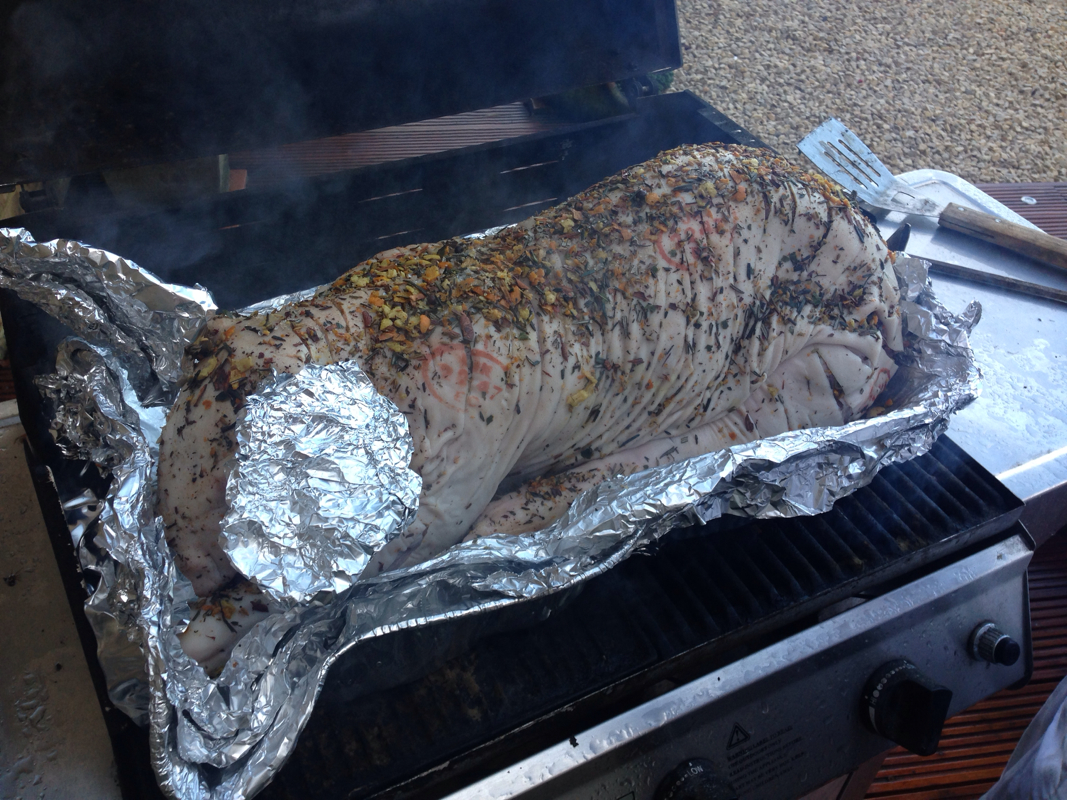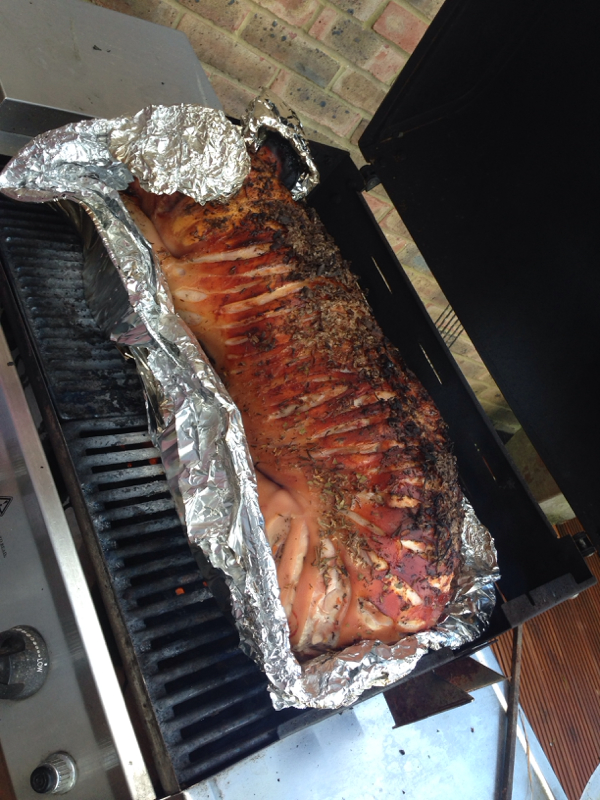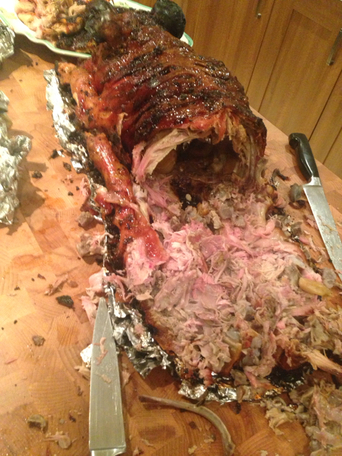There is no meat quite so delicious as that of the pig. Juicy, succulent, brimming with salty juice and with the natural texture of exquisite crackling. The King of meats! And if pork is the King, surely that makes the Crown Prince the fabulous suckling pig.
This Christmas our family tried something a little different from your average turkey, and decided to celebrate our holidays with a festive suckling pig. This recipe can be cooked though at any time of the year and makes for a fabulous way to entertain.
This Christmas our family tried something a little different from your average turkey, and decided to celebrate our holidays with a festive suckling pig. This recipe can be cooked though at any time of the year and makes for a fabulous way to entertain.
The Pig
What is a suckling pig? Technically a suckling pig is one that is still on its mother’s milk – so anything up to around 6 weeks. Commonly what gets sold and branded as ‘suckling’ is actually a little older, at around 8 weeks, but it who’s counting really.
Why is it so good? Suckling pig has been eaten for thousands of years – we have sources telling us of the Romans chowing down on this yummy old Babe! One of the reasons that make it so delicious is that piglets contain a much higher proportion of collagen than their hoary elders. This, when cooked, breaks down to make its flesh sticky, rich and excessively juicy. It’s a far more gelatinous, luxurious mouthful than normal pork.
What is a suckling pig? Technically a suckling pig is one that is still on its mother’s milk – so anything up to around 6 weeks. Commonly what gets sold and branded as ‘suckling’ is actually a little older, at around 8 weeks, but it who’s counting really.
Why is it so good? Suckling pig has been eaten for thousands of years – we have sources telling us of the Romans chowing down on this yummy old Babe! One of the reasons that make it so delicious is that piglets contain a much higher proportion of collagen than their hoary elders. This, when cooked, breaks down to make its flesh sticky, rich and excessively juicy. It’s a far more gelatinous, luxurious mouthful than normal pork.
Logistics
Size matters. Suckling piggies come in a number of delicious sizes. For about 6-8 people go for about a 5kg piglet, and aim for about 750g per person after that. Bear in mind, you won’t be able to fit more than about a 6kg pig in a domestic oven. There are ways round cooking a larger one, such as cutting it half, or doing it on a spit on a BBQ, or roasting in a BBQ, but do just bear in mind your facilities when purchasing your pig.
We ended up cooking our pig in our BBQ in a huge roasting tray, since it wouldn’t fit in our oven.
Purchasing it. You can order this in at your butchers or look online for a local farm selling them. Try to buy organic and free range. It’s much nicer on the poor little piggy while it lives. Also – do try and buy British. This year we got ours from a fabulous farm up in Yorkshire called Mount Grace – it was delicious and I couldn’t recommend it enough. A 8 kilo pig costs around £95, so it’s not cheap, but then again it’s not much more than a good turkey and will serve a hell of a lot more people.
To brine or not to brine. I say brine! Brining is the process of soaking meat in a salted solution over an extended period of time in order to tenderise the meat and make it more juicy. As it soaks in the water, it absorbs up to 8% more water and some of the proteins in the muscle fibres dissolve, making the flesh softer and moister.
Mental preparation. The pig will arrive whole. Prepare for this. It should be gutted, but its head will be on and eyes in. Don’t be a baby and just get stuck in. Do not name the pig. It will be very heavy and lugging it around, putting it into bin bags to brine it will make you feel, and appear at first glance, like a murderer. Try not to let the neighbours see – it makes for some awkward 999 calls.
Size matters. Suckling piggies come in a number of delicious sizes. For about 6-8 people go for about a 5kg piglet, and aim for about 750g per person after that. Bear in mind, you won’t be able to fit more than about a 6kg pig in a domestic oven. There are ways round cooking a larger one, such as cutting it half, or doing it on a spit on a BBQ, or roasting in a BBQ, but do just bear in mind your facilities when purchasing your pig.
We ended up cooking our pig in our BBQ in a huge roasting tray, since it wouldn’t fit in our oven.
Purchasing it. You can order this in at your butchers or look online for a local farm selling them. Try to buy organic and free range. It’s much nicer on the poor little piggy while it lives. Also – do try and buy British. This year we got ours from a fabulous farm up in Yorkshire called Mount Grace – it was delicious and I couldn’t recommend it enough. A 8 kilo pig costs around £95, so it’s not cheap, but then again it’s not much more than a good turkey and will serve a hell of a lot more people.
To brine or not to brine. I say brine! Brining is the process of soaking meat in a salted solution over an extended period of time in order to tenderise the meat and make it more juicy. As it soaks in the water, it absorbs up to 8% more water and some of the proteins in the muscle fibres dissolve, making the flesh softer and moister.
Mental preparation. The pig will arrive whole. Prepare for this. It should be gutted, but its head will be on and eyes in. Don’t be a baby and just get stuck in. Do not name the pig. It will be very heavy and lugging it around, putting it into bin bags to brine it will make you feel, and appear at first glance, like a murderer. Try not to let the neighbours see – it makes for some awkward 999 calls.
How to cook it
To cook our pig, we used a combination of Jamie Oliver’s Christmas suckling pig recipe, some guidance from some excellent blog posts, such as that of The Food Lab, and a bit of our own mother-daughter meddling. You’ll need at least 24 hours in advance of the meal to prep it.
See the below recipe. Feel free to eliminate the rub stage – it’s delicious just with salt and pepper.
To cook our pig, we used a combination of Jamie Oliver’s Christmas suckling pig recipe, some guidance from some excellent blog posts, such as that of The Food Lab, and a bit of our own mother-daughter meddling. You’ll need at least 24 hours in advance of the meal to prep it.
See the below recipe. Feel free to eliminate the rub stage – it’s delicious just with salt and pepper.
Ingredients (serves 8):
1 suckling pig (approx. 8 kilos)
3 clementines
340g good marmalade
2 apples
2 red onions
Salt and Pepper
For the brine:
17 litres of water
6.5 cups of salt
4.5 cups of sugar
For the rub (Jamie’s Christmas Rub!):
2 orange
1 lemon
8 fresh bay leaves
8 allspice berries
4 tablespoons fennel seeds
16 tablespoons sea salt
2 stick cinnamon
8 sprigs fresh rosemary, leaves picked
8 sprigs fresh thyme, leaves picked
1 nutmeg
Extras: tinfoil, string, bin bags, a huge roasting tray
1 suckling pig (approx. 8 kilos)
3 clementines
340g good marmalade
2 apples
2 red onions
Salt and Pepper
For the brine:
17 litres of water
6.5 cups of salt
4.5 cups of sugar
For the rub (Jamie’s Christmas Rub!):
2 orange
1 lemon
8 fresh bay leaves
8 allspice berries
4 tablespoons fennel seeds
16 tablespoons sea salt
2 stick cinnamon
8 sprigs fresh rosemary, leaves picked
8 sprigs fresh thyme, leaves picked
1 nutmeg
Extras: tinfoil, string, bin bags, a huge roasting tray
Method:
1. For the rub: peel the zest from the oranges and lemons. Add this, the bay leaves, all spice berries, fennel seeds and cinnamon to a blender and pulse until roughly ground. Add the rosemary and thyme, and pulse. Stir in the nutmeg and salt. This will keep for a few weeks so you can make it in advance and use it when convenient.
2. For the pig: The first stage is to brine the pig. It’s probably easiest to do this in bin bags, unless you have a large cooler or ice bucket you can use. Put the pig into three layers of bin bags (to stop leakage) and pour in the brining solution. Keep this in a cool place, covered in ice (e.g. in an ice cooler chest or in a bath covered with ice), for 12-24 hours.
3. Next the rub. Take the pig out of the brine and dry it with a towel to remove excess moisture. Score the skin all over with a sharp knife, being careful not to cut through into the flesh, about 0.75 of an inch apart. Stuff the pig’s insides with the apple, 2 of the clementines and the red onion. If there is any spare room, add some scrunched up tinfoil, to fill up the cavity. Sew the cavity up with the string – this helps hold the pig together a bit. Pop the remaining clementine into its mouth. Put the pig into its roasting tray and sit it upright, in a sort of sphinx position. This gives it maximum skin surface area exposure for plentiful crackling. See the photo below. Coat the pig with the rub and refrigerate for a further 12 hours.
4. To cook: heat the oven to its maximum setting (circa 220 celsius). Cover the pigs ears and tail with tin foil to stop them burning. Put the pig into the oven and turn the heat down to 180 celsius. Roast for around 5 hours at this temperature, or until the internal temperature of the pig reaches 75 degrees. If the back or any other part starts looking a little too dark, cover it with tinfoil. When there are only ten minutes remaining of cooking, remove it from the oven and glaze it with all the marmalade. This gives it a lovely flavour and shine.
5. Once cooked, it should be glossy brown with crispy skin all over. Rest it for around 30 minutes, covered in tin foil to keep it warm.
6. To serve: if you want to carve it, rather than just attack it with your hands like animals, cut around the neck and then down the spine to the tail, to separate off both sets of ribs. Remove the loin and belly meat from below the ribs.
DEVOUR. Immediately and with great enthusiasm.
1. For the rub: peel the zest from the oranges and lemons. Add this, the bay leaves, all spice berries, fennel seeds and cinnamon to a blender and pulse until roughly ground. Add the rosemary and thyme, and pulse. Stir in the nutmeg and salt. This will keep for a few weeks so you can make it in advance and use it when convenient.
2. For the pig: The first stage is to brine the pig. It’s probably easiest to do this in bin bags, unless you have a large cooler or ice bucket you can use. Put the pig into three layers of bin bags (to stop leakage) and pour in the brining solution. Keep this in a cool place, covered in ice (e.g. in an ice cooler chest or in a bath covered with ice), for 12-24 hours.
3. Next the rub. Take the pig out of the brine and dry it with a towel to remove excess moisture. Score the skin all over with a sharp knife, being careful not to cut through into the flesh, about 0.75 of an inch apart. Stuff the pig’s insides with the apple, 2 of the clementines and the red onion. If there is any spare room, add some scrunched up tinfoil, to fill up the cavity. Sew the cavity up with the string – this helps hold the pig together a bit. Pop the remaining clementine into its mouth. Put the pig into its roasting tray and sit it upright, in a sort of sphinx position. This gives it maximum skin surface area exposure for plentiful crackling. See the photo below. Coat the pig with the rub and refrigerate for a further 12 hours.
4. To cook: heat the oven to its maximum setting (circa 220 celsius). Cover the pigs ears and tail with tin foil to stop them burning. Put the pig into the oven and turn the heat down to 180 celsius. Roast for around 5 hours at this temperature, or until the internal temperature of the pig reaches 75 degrees. If the back or any other part starts looking a little too dark, cover it with tinfoil. When there are only ten minutes remaining of cooking, remove it from the oven and glaze it with all the marmalade. This gives it a lovely flavour and shine.
5. Once cooked, it should be glossy brown with crispy skin all over. Rest it for around 30 minutes, covered in tin foil to keep it warm.
6. To serve: if you want to carve it, rather than just attack it with your hands like animals, cut around the neck and then down the spine to the tail, to separate off both sets of ribs. Remove the loin and belly meat from below the ribs.
DEVOUR. Immediately and with great enthusiasm.

